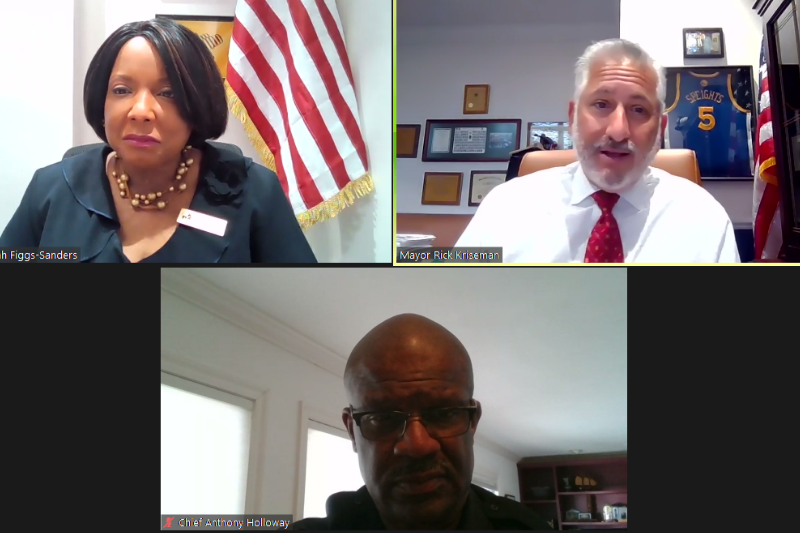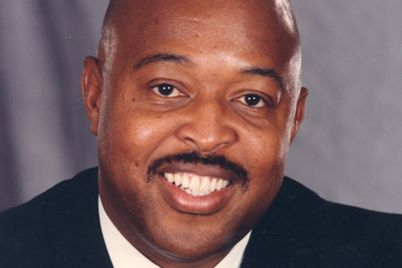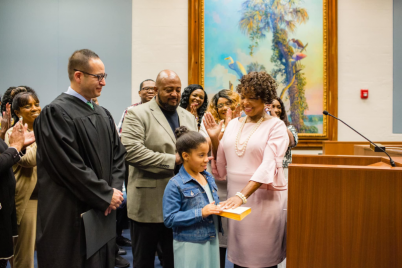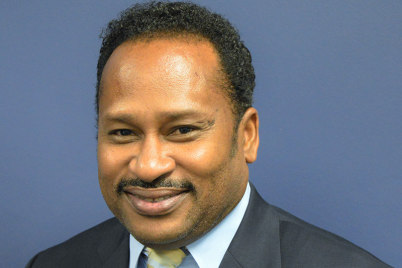City Councilmember Deborah Figgs-Sanders, Mayor Rick Kriseman, and Police Chief Anthony Holloway held a virtual public discussion with community members earlier this month.
FRANK DROUZAS, Staff Writer
ST. PETERSBURG — To address rising violence in St. Pete, City Councilmember Deborah Figgs-Sanders, Anthony Holloway, St. Petersburg Police Chief, and Mayor Rick Kriseman held a public discussion with community members earlier this month.
While five homicides were committed in the city in 2020, that number has already tripled to 15 so far this year as of April 12. In a disturbing trend, all the homicides by firearms have been by African Americans toward African Americans. It is the responsibility of law enforcement, residents, and elected officials to come together and discern how to alleviate the violence, Figgs-Sanders said.
“We’re going to need everyone to take a role in this village that we call the city of St. Petersburg,” she said, “because when it impacts one community, it impacts all of our communities.”
The mayor believes part of the problem is that there are too many illegal guns on the street, and access to them is relatively easy. This includes weapons stolen from vehicles that find their way onto the streets and are used for the wrong purpose.
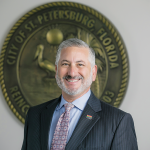
Mayor Rick Kriseman
“Unfortunately, it has made it far too easy for people to start solving disputes and arguments by pulling out a weapon,” said Kriseman, who joined the Mayors Against Illegal Guns coalition when he first took office in 2014.
Programs such as “Not My Son,” launched in 2015 in response to a rash of shootings, has been effective in curbing some of the violence, Kriseman said, mostly because it’s been the government partnering with the community to effect change.
Stress and mental health issues related to the pandemic and jobs lost because of it may also be a factor in the rising violence, he said.
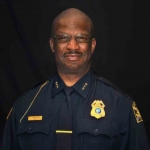
Police Chief Anthony Holloway
Holloway noted that though there have been 15 homicides in 2021 to date, the SPPD has been able to close out each one with an arrest, with two persons responsible for six out of the 15 deaths.
Responsible gun owners must secure their weapons, the chief pointed out, as unlocked cars are a temptation to some. In tracking down stolen cars, police officers find guns in about 30 percent of them, Holloway estimated.
Bartlett Park resident Tom Tito said in years past, people marched throughout Bartlett Park carrying pictures of young people lost to gun violence, mostly because of shootings involving illegal drugs. As this resonated deeply within the community, he wondered if something similar could be done now to harness the grief.

Councilmember Deborah Figgs-Sanders
Figgs-Sanders noted that she and other city council members helped launch the Enough is Enough campaign, which would bring awareness of the gun violence problem directly to the neighborhoods. Holloway noted the SPPD sends an Impact Team into areas where there has been violence and has made 88 arrests but underscored that people need to learn to solve problems without pulling guns.
Tom Lally of the Council of Neighborhood Associations asked about a city mentoring program for youths. Kriseman explained that the city is creating several programs with the local school district — on the high school and university levels — to create opportunities to transition from an educational institution to employment with the city, including the police department, fire department, and public works. Pinellas Technical College is one such institution that has been an active partner with the city in helping create pathways to city jobs.
“We are going to have people aging out, and a job with the city is a good job,” the mayor said, adding that it’s not about just jobs but careers.
Michael Jalazo, CEO and executive director of Pinellas Ex-Offender Re-Entry Coalition, suggested that funds allocated to St. Pete under the American Rescue Plan could be used for community support-led safety initiatives; Kriseman said the city is open to putting these monies, once secured, to such use.
Activist Ruth Whitney asked Holloway if he has conversations with his officers and community members about what can be done to stop the violence among young people. The chief explained the department plans to restart its Park, Walk and Talk initiative –suspended during the pandemic — and put its police command bus back into communities. Officers visit different parks and recreation centers as well to communicate directly with residents, he said.
“Also, our school resource officers will have conversations with the kids in the schools,” Holloway said.
He added that the police department’s anonymous tip line and improvements in forensics are improving policing in the city going forward.
“With the technology and the information that we get from the community, we can solve this problem together,” he said.
Community activist Matt Byrd pointed out that those closest to the problem are closest to the solution, but there is often a gap between them and the resources that could provide any solutions. Kriseman said he is open, as he has always been, to regarding new approaches and listening to fresh voices.
“Our intent isn’t to create a wall and create a barrier between the community and administration or city hall,” Kriseman responded. It works best when we’re all working together collaboratively. If we are doing things as a city government that is interfering with your ability to even communicate with us, let us know that.”
Carlos Daniels of the Cohort of Champions, a youth training initiative, recommended employing staff workers at city parks, overseeing recreational activities, to whom young people could easily reach out if they had a problem within their neighborhoods or even their homes.
These workers and coaches would be able “to utilize the services that we have through the city, for wraparound services for the community as a whole.” An occasional police presence would be beneficial, Daniels added, as law enforcement officers could even help with various recreational activities.
Community activist Ashley Green brought up the idea of utilizing community recreation centers for restorative justice training, peer mediation and conflict resolution, and “violence interrupters” in the streets for everyday gatherings, much like Chicago’s Peace Academy and similar programs.
“So when we have these gatherings in these big, public spaces, and tensions run high and someone reaches for a gun,” she said, “there’s somebody there that’s a peer that is respected by another peer to help de-escalate the situation.”
Kriseman and Holloway both expressed interest in looking into such violence-reducing programs for St. Pete.
To reach Frank Drouzas, email fdrouzas@theweeklychallenger.com

